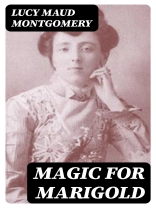In ‘Magic for Marigold, ‘ Lucy Maud Montgomery weaves a charming tale that intertwines the innocence of childhood with the complexities of growing up. Set against the picturesque backdrop of Prince Edward Island, the novel explores the life of a imaginative young girl named Marigold, who discovers a world filled with enchantment and adventure. Montgomery’s lyrical prose, rich character development, and vivid landscapes evoke a nostalgic atmosphere reminiscent of her more renowned works like ‘Anne of Green Gables, ‘ while addressing themes of self-discovery, friendship, and the magic inherent in everyday life. Lucy Maud Montgomery, a celebrated Canadian author, is best known for her novels that delve into the everyday experiences of girls in rural settings, drawing from her own upbringing and experiences in early 20th-century Canada. Her affinity for nature and deep understanding of the human condition reveal themselves in Marigold’s journey, reflecting Montgomery’s belief in the transformative power of imagination and the importance of human connections. This novel showcases her adeptness in capturing the essence of childhood wonder, serving as a guiding light as she navigates the trials of adolescence. ‘Magic for Marigold’ is a delightful read that captivates both young and mature audiences alike. Montgomery’s enchanting storytelling offers profound insights into the intricacies of growing up, making this work a perfect addition to any reader’s collection. Ideal for lovers of classic literature and those seeking a heartwarming escape, this novel reiterates Montgomery’s legacy as a masterful storyteller.
A propos de l’auteur
Lucy Maud Montgomery (1874–1942) was a distinguished Canadian author, best known for her enchanting tales that capture the essence of rural life on Prince Edward Island. Born on November 30, 1874, in Clifton (now New London), Montgomery was raised by her grandparents after her mother’s death and her father’s departure. Her literary journey began when she started to keep a journal and became a teacher, although her passion always remained in writing. Montgomery’s career took flight with the publication of ‘Anne of Green Gables’ in 1908, a book that would not just seal her prominence but also introduce readers to her beloved province and its spirited inhabitants. Her writing style is characterized by its vivid depictions of landscape, the incorporation of strong, independent female protagonists, and a fondness for domestic life imbued with a sense of optimism. ‘Magic for Marigold’, albeit less famous than her Anne series, is a testament to Montgomery’s skill in crafting rich, character-driven stories that continue to resonate with readers. It is a narrative filled with whimsy and poignancy, exploring themes of imagination and family dynamics. This, like many of her works, illustrates Montgomery’s ability to blend realism with the idyllic, a literary technique that earned her a permanent place in the pantheon of classic children’s literature. Her legacy endures, her books continue to be widely read, and she remains a cherished figure in Canadian literary history.












